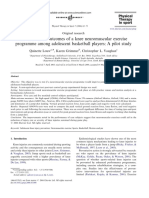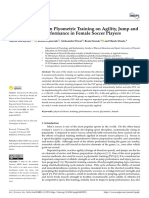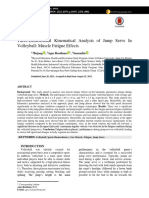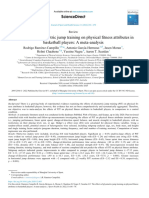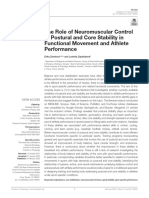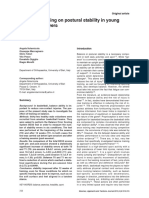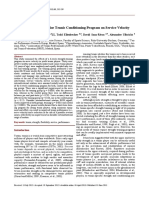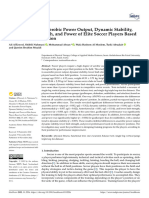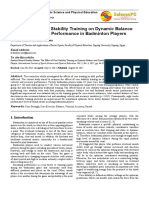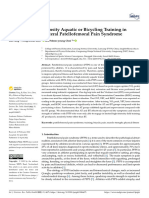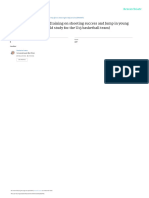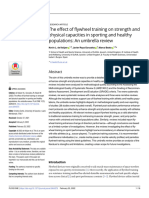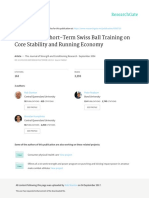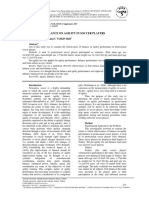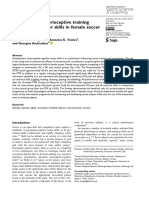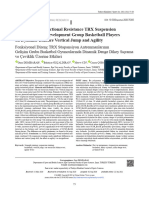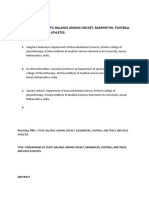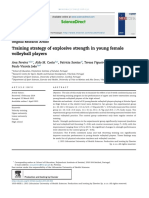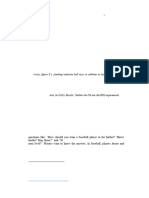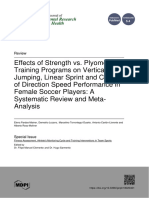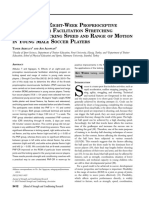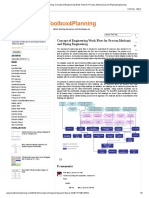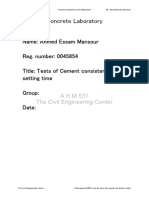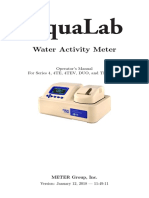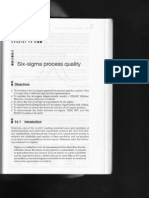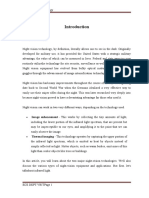Pone 0305245
Pone 0305245
Uploaded by
samueldelossantos.fisioterapiaCopyright:
Available Formats
Pone 0305245
Pone 0305245
Uploaded by
samueldelossantos.fisioterapiaOriginal Title
Copyright
Available Formats
Share this document
Did you find this document useful?
Is this content inappropriate?
Copyright:
Available Formats
Pone 0305245
Pone 0305245
Uploaded by
samueldelossantos.fisioterapiaCopyright:
Available Formats
PLOS ONE
RESEARCH ARTICLE
The effect of core stability training on ball-
kicking velocity, sprint speed, and agility in
adolescent male football players
Ceyda Sofuoğlu ID1☯*, Zehra Güçhan Topçu2, Volga Bayrakcı Tunay3☯
1 Fizyo & Osteopathy Physical Therapy and Healthy Life Center, Nicosia, Cyprus, 2 Faculty of Physical
Therapy and Rehabilitation, University of Hacettepe, Ankara, Turkey, 3 Faculty of Health Sciences, Physical
Therapy and Rehabilitation Department, Eastern Mediterranean University, Famagusta, Cyprus
☯ These authors contributed equally to this work.
a1111111111 * ceyda_sofuoglu@hotmail.com
a1111111111
a1111111111
a1111111111
a1111111111 Abstract
This study was conducted to investigate the effect of core stability training program on ball-
kicking velocity, running speed, and agility in adolescent male football players. To this end,
36 male football players aged 12–14 were divided into the training group and control group.
OPEN ACCESS Before implementing the core stability training program, participants’ ball-kicking velocity,
Citation: Sofuoğlu C, Güçhan Topçu Z, Bayrakcı sprint speed, and agility performance were measured with a Bushnell velocity radar gun, 20
Tunay V (2024) The effect of core stability training m sprint test, and 505 agility test, respectively, in both training group and control group. After
on ball-kicking velocity, sprint speed, and agility in
the measurements, the training group followed core stability training program three days a
adolescent male football players. PLoS ONE 19(6):
e0305245. https://doi.org/10.1371/journal. week, for eight weeks in addition to the routine training program, while the control group fol-
pone.0305245 lowed the routine training program only. Ball-kicking velocity, sprint speed, and agility perfor-
Editor: Holakoo Mohsenifar, Iran University of mance were re-measured in both groups after the completion of the core stability training
Medical Sciences, ISLAMIC REPUBLIC OF IRAN program. Significant improvements were detected in all parameters, i.e., ball-kicking veloc-
Received: January 21, 2024 ity, sprint speed, and agility performance in the training group (p<0.05). On the other hand,
in the control group, no significant change was detected in the ball-kicking velocity and sprint
Accepted: May 25, 2024
speed (p>0.05), whereas a significant improvement was observed in agility performance
Published: June 21, 2024
(p<0.05). Inter-group comparisons revealed statistically significant differences between the
Peer Review History: PLOS recognizes the groups in ball-kicking velocity and sprint speed in favor of the training group (p<0.05), while
benefits of transparency in the peer review
no significant difference was found between the groups in agility performance (p>0.05). In
process; therefore, we enable the publication of
all of the content of peer review and author conclusion, this study’s findings suggest that core stability exercises can be incorporated
responses alongside final, published articles. The into the routine training program of adolescent male football players.
editorial history of this article is available here:
https://doi.org/10.1371/journal.pone.0305245
Copyright: © 2024 Sofuoğlu et al. This is an open
access article distributed under the terms of the
Creative Commons Attribution License, which Introduction
permits unrestricted use, distribution, and
reproduction in any medium, provided the original Football is a game based on muscular performance, requiring the player to perform repetitive
author and source are credited. and high-intensity movements such as sudden acceleration and deceleration, changing direc-
Data Availability Statement: All relevant data are
tion, jumping, and landing [1]. It involves intermittent physical activities necessitating intense
within the manuscript and its Supporting running in different directions during the game. Although football mainly involves running,
Information files. explosive moves such as sprinting, jumping, and kicking the ball are required [1,2].
PLOS ONE | https://doi.org/10.1371/journal.pone.0305245 June 21, 2024 1 / 16
PLOS ONE Adolescent football and core stability training
Funding: The author(s) received no specific In adolescent football players, overuse injuries occur at a rate of 10–40%. The majority (60–
funding for this work. 90%) of injuries are observed in the lower extremity, including the ankle and thigh. The most
Competing interests: The authors have declared common types of injuries are strains, sprains, and contusions [3,4]. Approximately 40%–60%
that no competing interests exist. of injuries occur due to contact with another player or object during the game [5]. Conse-
quently, adolescents have an increased risk of injury from repetitive mechanical stress [6].
The core muscle group is defined as a muscle corset consisting of the abdominals in the
front, the erector spinae and gluteals in the back, the diaphragm as the roof, and the pelvic
floor and hip girdle muscles at the bottom [7]. These muscles collectively support the spine
and trunk during upper and lower extremity movements such as jumping, throwing, running,
and kicking the ball [8]. Kibler [9] explains core stability based on the principle of ‘‘proximal
stability for distal mobility.” According to this principle, optimal transfer and control of power
and movement transmitted to the distal segments during sports activities are achievable
through the ability to control the position and movement of the trunk on the lower extremities
and pelvis [9]. Brown [7] adds that core stability is achieved through the dynamic restriction
provided by the core muscles and the passive stiffness contributed by the vertebrae, fascia, and
ligaments [11]. Panjabi [10] further notes that, in addition to bone, ligament, and muscle
structures, the central nervous system also plays a role in contributing to core stability by pro-
viding neuromuscular control [10].
Training the core muscles is expected to enhance athletic performance and reduce injuries
[9,11]. Studies indicate that disorders in core muscle strength and endurance, proprioception,
and neuromuscular control of core muscles, which can affect core stability, are important risk
factors in the development of lower extremity injuries [12,13]. The effect of core stability train-
ing (CST) on athletic performance has been and continues to be studied. Previous studies
revealed that a CST program increased some parameters of general performance and sport-
specific performance in badminton, handball, baseball, basketball, football, swimming, tennis,
rhythmic gymnastics, and modern dance [14–23].
Although many studies in the literature investigate the effect of core exercise training on
performance, only a few studies look into the effects of a CST program in adolescent football
players [3,12]. We hypothesized that core stability exercises would improve ball-kicking veloc-
ity, sprint speed, and agility in adolescent male football players.
Methods
Experimental approach to the problem
The minimum number of participants required for a study power of 0.95 and alpha error 0.05
was determined using G Power 3.0.10 G Software for Windows (Heinrich-Heine-Universität
Düsseldorf, Düsseldorf, Germany). The results revealed that 36 players are needed. To evaluate
the effect of CST, 45 adolescent male football players who were on a similar training program,
met the study criteria, and whose legal guardians signed the informed consent form were
divided into the training group (TG) (n = 23) and control group (CG) (n = 22) (Fig 1). The TG
followed the CST program three days a week for 8 weeks in addition to the routine training
program, while the CG followed the routine training program only. The participants’ ball-
kicking velocity, sprint speed, and agility performances were evaluated by the same physiother-
apist before training and eight weeks after training. Measurements data were collected at the
beginning of the study and after the completion of the 8 weeks CST program. October 1, 2021
pre-study measurements were completed. CST program was implemented between the dates
October 2, 2021- November 27, 2021. November 29, 2021 post-study measurements were
repeated.
PLOS ONE | https://doi.org/10.1371/journal.pone.0305245 June 21, 2024 2 / 16
PLOS ONE Adolescent football and core stability training
Fig 1. Flowchart of the study.
https://doi.org/10.1371/journal.pone.0305245.g001
Subjects
The protocol of this study was approved by the Eastern Mediterranean University Health Eth-
ics Subcommittee Presidency prior to the conduct of the study. The study population consisted
of male adolescent football players aged between 12–14, playing football at the youth setup of a
football academy. The study inclusion criteria were determined as not having any pain com-
plaints involving the lower extremities and spine, should had no surgery before of the study,
not having a pathological condition, and participating regularly in training. On the other
hand, the study exclusion criteria were determined as having taken a break from sports, not
having participated in training more than three times, and having difficulty following exercise
programs.
Measurements
Ball-kicking velocity test. Kicking velocity was measured using a Bushnell velocity radar
gun (Bushnell Performance Optics, Overland Park, KS, US) [24]. To this end, the ball was
placed at a distance of 15 m from the goal. The tripod support of the velocity radar gun was set
at a height of 1.22 m from the ground and kept 1 m behind the goal. The participants were
PLOS ONE | https://doi.org/10.1371/journal.pone.0305245 June 21, 2024 3 / 16
PLOS ONE Adolescent football and core stability training
asked to run from a distance of 5 m and kick the ball with maximum force. A test kick was
made, followed by three kicks. The average of these three kicks was recorded in km/h. In
accordance with the International Federation of Association Football (FIFA) standards, 12-to-
13-year-olds made the kicks with a number 4 soccer ball, and 14-year-olds made the kicks with
a number 5 soccer ball [25,26]. Radar guns are a common tool both in practical use and scien-
tific research due to their high accuracy (ICC> 0.94) [27,28].
Sprint speed test. Sprint speed was measured via the 20 m sprint test. To this end, the par-
ticipants were asked to start the sprint run 50 cm behind the starting line, and the time to com-
plete 20 m was recorded in seconds. Sprint test was conducted using a stopwatch. The
reliability of 20 m sprint test among U12 (ICC = 0.73), U13 (ICC = 0.90) and U14 (ICC = 0.83)
has been demonstrated [29].
Agility test. Agility performance was measured with the 505 agility test developed by
Draper and Lancaster in 1985. To this end, the participants were first asked to complete a 10 m
approach run, followed by moving back a distance of 5 m, making a 180˚ turn, and returning.
The time it took for the participants to cover the said 5 m distance back and forth was recorded
in seconds. Agility test was conducted using a stopwatch. The reliability of 505 agility test
among U12 (ICC = 0.57), U13 (ICC = 0.91) and U14 (ICC = 0.89) has been demonstrated [29].
Training program
Following the completion of performance assessment measurements, an exercise diary was
created to track participants’ attendance in the study. Subsequently, the TG followed the CST
program in addition to the routine training program during the season for eight weeks, three
days a week, under the supervision of the same physiotherapist. The program was imple-
mented in three phases. Accordingly, phases 1, 2 and 3 were implemented between 1st–3rd,
3rd–5th, and 5th–8th weeks, respectively. Before the initiation of the program, transversus abdo-
minis muscle and multifidus muscle contraction were explained and checked by palpation to
enhance motor control, endurance, and kinesthetic awareness. This was followed by four ses-
sions of individual training, including instructions on maintaining a neutral spine position,
abdominal hallowing, and abdominal bracing techniques, utilizing a pressure biofeedback
device. Ankle weights, dumbbells, resistance bands, and physio balls were incorporated into
the program. The exercise equipments’ used by participants were determined by verbally ask-
ing them about the weights they could lift ten times in a row without difficulty. Exercise inten-
sity progressively increased every phases. From week 1–3 exercises were repeated 15 times, 1
set. From week 3–5 exercises were repeated 12 times, 2 sets. From week 5–8 exercises were
repeated 10 times, 3 sets. The rest period between sets was one minute in all training phases.
The exercise program content was changed every phases; thus, duration of the sessions was ini-
tially 40 minutes and increased to 60 minutes in the following weeks. Warm-up exercises were
performed for 10 minutes before each session, and a 10-minute cool-down program was
applied at the end of each session. The details of the CST program are outlined in Table 1.
Statistical analysis
The descriptive statistics obtained from the collected data were tabulated as mean ± standard
deviation or median with minimum and maximum values, depending on the normal distribu-
tion characteristics of continuous (numerical) variables. Categorical variables were presented
as numbers and percentages. Normal distribution characteristics of numerical variables were
assessed using the Shapiro-Wilk, Kolmogorov-Smirnov, and Anderson-Darling tests. In com-
parisons of two independent groups, the independent samples t-test or Mann-Whitney U test
was used for normally and non-normally distributed numerical variables, respectively. For
PLOS ONE | https://doi.org/10.1371/journal.pone.0305245 June 21, 2024 4 / 16
PLOS ONE Adolescent football and core stability training
Table 1. Core stability training program.
Core Stability Exercises Phase 1 (1–3 Weeks)
1- Supine abdominal draw in with knee to chest X15, 1 set
2- Supine abdominal draw in with heel side X15, 1 set
3- Supine abdominal draw in with double knee to chest X15, 1 set
4- Supine twist with abdominal drawing X15, 1 set
5- Side lying clam exercise X15, 1 set
6- Side lying leg-arm ipsilateral abduction X15, 1 set
7- Side bridging on elbow hold 10 seconds X15, 1 set
8- Prone position superman hold 10 seconds X15, 1 set
9- Prone position alternate superman hold 5 seconds X15, 1 set
10- Quadruped position abdominal drawing hold 5 seconds X15, 1 set
11- Quadruped alternate arm and leg lift X15, 1 set
12- Quadruped knee lifts hold 5 seconds X15, 1 set
13- Prone plank on feet hold 5 seconds X15, 1 set
14- Supine bridge with arms at side hold 5 seconds X15, 1 set
15- Supine bridge with arms across chest hold 5 seconds X15, 1 set
16- Supine bridge with knee extension hold 5 seconds X15, 1 set
17- Supine bridge with single leg marching (hip and knee bent to 90 degrees) hold 5 seconds X15, 1 set
18- Seated on physioball abdominal drawing hold 5 seconds X15, 1 set
19- Seated on physioball add marching hold 5 seconds X15, 1 set
Core Stability Exercises Phase 2 (3–5 Weeks)
1-Supine dead bugs X12, 2 sets
2-Rolling like a ball hold 2 seconds in starting position X12, 2 sets
3- Side bridge on feet with hip abduction X12, 2 sets
4- Prone bridge on elbows with hip extension X12, 2 sets
5- Prone bridge on hands, start with quadruped knee lift position X12, 2 sets
6- Quadruped alternate arm/leg lifts with cuff and dumbbell weight X12, 2 sets
7- Abdominal crunches on physioball hold 2 seconds X12, 2 sets
8-Abdominal crunches on physioball with rotation hold 2 seconds X12, 2 sets
9- Bridging with heaf on physioball hold 5 seconds X12, 2 sets
10- Supine bridging on physioball hold 5 seconds X12, 2 sets
11- Supine bridging on physioball with arms in 90 degrees’ shoulder flexion and alternate leg lifts X12, 2 sets
12- Straight leg lowering/lifting with physioball between legs X12, 2 sets
13- Physioball decline push-up X12, 2 sets
14- Seated on physioball with leg extension hold 5 seconds X12, 2 sets
Core Stability Exercises Phase 3 (5–8 Weeks)
1- Supine bridge with feet on physioball hold 5 seconds, add alternate knee extension X10, 3 sets
2- Physioball jackknife X10, 3 sets
3- Prone position on physioball catching and throwing a football ball with partner X10, 3 sets
4- Side position on physioball catching and throwing a football ball with partner X10, 3 sets
5- Standing upright position hip flexion, extension, abduction and adduction with elastic resistance band X10, 3 sets
6- Standing upright position catching and throwing a physioball with partner X10, 3 sets
7- At squat position catching and throwing a football ball with partner X10, 3 sets
8- At single leg stance catching and throwing a physioball with partner X10, 3 sets
9- Walking lunges with catching and throwing a football ball X10, 3 sets
10- Simultaning to kick with inside of foot while catching a physioball (elastic resistance band added) X10, 3 sets
11- Simultaning to kick with outside of foot while catching a physioball (elastic resistance band added) X10, 3 sets
12- Simultaning to kick with top of foot while catching a physioball (elastic resistance band added) X10, 3 sets
13- Kicking a football ball inside, outside and top of the foot with partner (elastic resistance band added) X10, 3 sets
https://doi.org/10.1371/journal.pone.0305245.t001
PLOS ONE | https://doi.org/10.1371/journal.pone.0305245 June 21, 2024 5 / 16
PLOS ONE Adolescent football and core stability training
comparisons of two dependent groups, the paired samples t-test was applied. Statistical analy-
ses were conducted using Jamovi project 2.2.5.0 (Jamovi, version 2.2.5.0, 2022, retrieved from
https://www.jamovi.org) and JASP 0.16.1 (Jeffreys’ Amazing Statistics Program, version 0.16.1,
2022, retrieved from https://jasp-stats.org) software packages. A probability (p) value of � 0.05
was deemed to indicate statistical significance.
Results
During the study period, four and five participants from the TG and CG groups, respectively,
were excluded from the study. Three players from the TG did not participate regularly in CST
and one player had an orthopedic injury. Five participants from CG did not participate regu-
larly in routine training program. In the end, 19 and 17 participants completed the study in
the TG and CG, respectively (Fig 1). The age, height, weight, body mass index, and sports age
data of the participants showed a homogeneous distribution. The distribution of the partici-
pants’ demographic characteristics by the TG and CG is given in Table 2.
The inter-group comparisons after the completion of the CST program revealed significant
differences between the TG and CG. Accordingly, a significant difference was found between
the TG and CG in ball-kicking velocity after the completion of the program, in favor of the TG
(p = 0.002, d > 1). Similarly, the sprint speed test time was significantly higher in the CG than
in the TG after the completion of the program (p = 0.001, d > -1.2). There was a significant dif-
ference between the TG and CG in the median percent change in sprint speed, in favor of the
CG (p = 0.006). In parallel, the decrease in the time to complete the sprint speed test was signif-
icantly higher in the TG than in the CG (-5.56 [-21.03–4.13] sec. vs. -0.71 [-7.19–17.62] sec.).
The inter-group comparisons in agility performance parameters did not reveal any statistically
significant difference between the groups (p > 0.05). Effect size for time agility was d = -0.51
(CI = [-1.175–0.156]) (Table 3) (Figs 2–4).
The intra-group comparisons revealed significantly higher ball-kicking velocity and signifi-
cantly lower sprint speed and agility test times with large effect sizes in the TG (p = 0.002, d =
-0.83; p < 0.001, d = 0.90; p < 0.001, d = 0.95 respectively) (Table 4) (Figs 2–4).
Table 2. Demographic characteristics data for training and control group.
Training group Control group Test Cohen’s d [95% CI] p-value
(n = 19) (n = 17) statistic
Age 13.05 ± 0.78 12.82 ± 0.81 135.500 0.161 [-0.217–0.497] 0.381**
13.00 [12.00–14.00] 13.00 [12.00–14.00]
Sports age 6.11 ± 2.26 5.24 ± 2.39 1.124 0.375 [-0.288–1.033] 0.269*
6.00 [1.00–10.00] 5.00 [2.00–9.00]
Body weight (kg) 54.00 ± 9.71 52.59 ± 8.75 0.451 0.152 [-0.504–0.807] 0.651*
52.00 [38.00–78.00] 51.00 [40.00–70.00]
Height (cm) 161.21 ± 7.76 159.18 ± 9.28 0.716 0.336 [-0.420–0894] 0.479*
162.00 [144.00–176.00] 158.00 [144.00–179.00]
Body mass index (kg/m2) 20.72 ± 3.13 20.72 ± 2.84 156.000 0.193 [-0.394–0.335] 0.862**
18.97 [17.30–28.31] 21.08 [16.42–28.15]
Descriptive statistics were expressed as mean ± standard deviation and median [minimum-maximum].
Test statistic: The numerical outcome of statistical tests comparing the demographic characteristics between the training and control groups.
CI: Confidence Interval.
p-values*: Results of Independent samples t-test.
p-values **: Results of Mann-Whitney u test.
https://doi.org/10.1371/journal.pone.0305245.t002
PLOS ONE | https://doi.org/10.1371/journal.pone.0305245 June 21, 2024 6 / 16
PLOS ONE Adolescent football and core stability training
Table 3. Comparison of inter group performance tests before and after the core stability exercise program.
Training group Control group Test Cohen’s d [95% CI] p-value
(n = 19) (n = 17) statistic
Ball kicking velocity (km/hour)
Before the Program 71.89 ± 16.21 67.71 ± 13.80 121.500 0.248 [-0.129–0.562] 0.204**
78.00 [35.00–92.00] 68.00 [29.00–88.00]
After the Program 81.05 ± 8.46 69.12 ± 13.04 3.292 1.099 [0.388–1.796] 0.002*†
82.00 [63.00–97.00] 69.00 [32.00–89.00]
Δ% 7.14 [-8.75–87.50] 4.41 [-14.71–19.61] 100.000 0.381 [0.018–0655] 0.051**
Sprint speed (sec)
Before the Program 3.86 ± 0.40 3.96 ± 0.25 -0.897 -0.300 [-0.956–0.361] 0.376*
3.78 [3.28–4.81] 4.00 [3.50–4.31]
After the Program 3.60 ± 0.23 3.95 ± 0.34 -3.706 -1.237 [-1.947 –-0.513] 0.001*†
3.59 [3.09–4.00] 3.94 [3.44–4.94]
Δ% -5.56 [-21.03–4.13] -0.71 [-7.19–17.62] 74.000 -0.542 [-0.757 –-0.220] 0.006***
Agility (sec)
Before the Program 3.03 ± 0.28 3.03 ± 0.20 -0.017 -0.006 [-0.660–0.649] 0.987*
2.94 [2.66–3.60] 2.96 [2.81–3.53]
After the Program 2.80 ± 0.28 2.93 ± 0.20 -1.536 -0.513 [-1.175–0.156] 0.134*
2.75 [2.41–3.58] 2.90 [2.68–3.40]
Δ% -4.82 [-21.94–4.07] -3.68 [-9.37–10.33] 122.000 -0.245 [-0.560–0.133] 0.211**
Descriptive statistics were expressed as mean ± standard deviation and median [minimum-maximum].
Δ%: Percentage difference between two times (positive values indicate increase, negative values indicate decrease).
Test statistic: The numerical outcome of statistical tests comparing the inter group performance tests before and after the program between the training and control
groups.
CI: Confidence Interval.
p-values
*: Results of Independent samples t-test.
p-values
**: Results of Mann-Whitney u test.
† Significate difference between training group and control group (p < 0.05).
https://doi.org/10.1371/journal.pone.0305245.t003
On the other hand, in the CG, no significant change was detected in the ball-kicking veloc-
ity and sprint speed (p > 0.05, d = -0.24; p > 0.05, d = 0.02 respectively), whereas a significant
improvement was observed in agility performance (p = 0.009, d = 0.71 CI = [0.171–1.242])
(Table 5) (Figs 2–4).
Discussion
This study aimed to investigate the effects of core stability exercises on ball-kicking velocity,
sprint speed, and agility in adolescent male football players. The findings of this study revealed
that the implementation of a CST program, in addition to the routine training program during
the season, is effective in improving ball-kicking velocity and sprint speed. On the other hand,
the CST program did not lead to a significant improvement in agility performance among ado-
lescent male football players. Although these results were generally consistent with previous
studies conducted with athletes from different age groups and genders, as well as healthy indi-
viduals, they also exhibit some differences in terms of certain sport-specific parameters.
Kicking the ball, an action that engages multiple joints, stands out as one of the most crucial
skills in football. The performance of ball-kicking relies on the maximum force and strength
PLOS ONE | https://doi.org/10.1371/journal.pone.0305245 June 21, 2024 7 / 16
PLOS ONE Adolescent football and core stability training
Fig 2. Ball kicking velocity pre- training and post- training values in TG and CG. TG = Training group, CG = Control
group.
https://doi.org/10.1371/journal.pone.0305245.g002
Fig 3. Sprint speed pre- training and post- training values in TG and CG. TG = Training group, CG = Control group.
https://doi.org/10.1371/journal.pone.0305245.g003
PLOS ONE | https://doi.org/10.1371/journal.pone.0305245 June 21, 2024 8 / 16
PLOS ONE Adolescent football and core stability training
Fig 4. Agility pre- training and post- training values in TG and CG. TG = Training group, CG = Control group.
https://doi.org/10.1371/journal.pone.0305245.g004
exerted by the foot responsible for both kicking the ball and providing support. Additionally, it
depends on the coordination between agonist muscles (including vastus lateralis, medialis, rec-
tus femoris, tibialis anterior, iliopsoas) and antagonist muscles (such as gluteus maximus,
biceps femoris, and semitendinosus) [30,31]. Wickstorm explains kicking the ball in four
phases: (1) the swing phase, where the thigh and shank are withdrawn; (2) the support phase,
where hip flexion begins; (3) ball impact, involving knee extension; and (4) the follow-through,
where both the hip and knee undergo flexion [25,32]. A review study, encompassing 96 studies
on the relationship between ball-kicking velocity and muscle strength, unveiled a significant
Table 4. Comparison of performance tests before and after the exercise program in the training group.
Training group Test Cohen’s d [95% CI] p-value
Before the Program After the Program Statistic
Ball kicking velocity (km/hour) 71.89 ± 16.21 81.05 ± 8.46 -3.637 -0.834 [-1.351 –-0.301] 0.002*†
78.00 [35.00–92.00] 82.00 [63.00–97.00]
Sprint speed (sec) 3.86 ± 0.40 3.60 ± 0.23 3.938 0.903 [0.358–1.431] <0.001*†
3.78 [3.28–4.81] 3.59 [3.09–4.00]
Agility (sec) 3.03 ± 0.28 2.80 ± 0.28 4.148 0.952 [0.397–1.488] <0.001*†
2.94 [2.66–3.60] 2.75 [2.41–3.58]
Descriptive statistics were expressed as mean ± standard deviation and median [minimum-maximum].
Test statistic: The numerical outcome of statistical tests comparing the performance tests before and after the exercise program in the training group.
CI: Confidence Interval.
p-values*: Results of paired samples t-test.
† Significant difference between before and after the program (p < 0.05).
https://doi.org/10.1371/journal.pone.0305245.t004
PLOS ONE | https://doi.org/10.1371/journal.pone.0305245 June 21, 2024 9 / 16
PLOS ONE Adolescent football and core stability training
Table 5. Comparison of performance tests before and after the exercise program in the control group.
Control group Test Cohen’s d [95% CI] p-value
Before the Program After the Program statistic
Ball kicking velocity (km/hour) 67.71 ± 13.80 69.12 ± 13.04 -0.995 -0.241 [-0.720–0.245] 0.335*
68.00 [29.00–88.00] 69.00 [32.00–89.00]
Sprint speed (sec) 3.96 ± 0.25 3.95 ± 0.34 0.212 0.027 [-0.449–0.502] 0.913*
4.00 [3.50–4.31] 3.94 [3.44–4.94]
Agility (sec) 3.03 ± 0.20 2.93 ± 0.20 2.949 0.715 [0.171–1.242] 0.009*†
2.96 [2.81–3.53] 2.90 [2.68–3.40]
Descriptive statistics were expressed as mean ± standard deviation and median [minimum-maximum].
Test statistic: The numerical outcome of statistical tests comparing the performance tests before and after the exercise program in the control group.
CI: Confidence Interval.
p-values*: Results of paired samples t-test.
† Significant difference between before and after the program (p <0.05).
https://doi.org/10.1371/journal.pone.0305245.t005
correlation between maximal isokinetic force and ball-kicking velocity in young football play-
ers. Conversely, the analysis of the results from explosive power tests and ball-kicking velocity
in young football players did not reveal any significant relationship between maximal strength,
explosive strength, and ball-kicking performance. They also found no significant relationship
between the results of the 10 m sprint test and ball-kicking velocity. The aforementioned
review study concluded that, despite the controversy surrounding the relationship between
strength and ball-kicking velocity, incorporating plyometric and explosive strength exercises
into the training routine may enhance maximum ball-kicking velocity [33]. Sporis et al. [26]
investigated the relationship between ball-kicking velocity and sprint speed with 27 football
players with an average age of 15±2.9. They measured ball-kicking speed using a velocity speed
gun and running speed through 5, 10, 20, and 30 m sprint tests. In the mentioned study, in
contrast to Lorenzo et al.’s [33] study, ball-kicking velocity was found to be significantly related
to running speed [26]. In a study examining the relationship between ball-kicking speed and
muscle strength, the dominant lower extremity strength of amateur football players was mea-
sured with an isokinetic dynamometer at 90˚ and 240˚ angular velocities. Consequently, it was
demonstrated that participants with greater knee extension concentric strength had signifi-
cantly higher ball-kicking speeds [34].
In our study, both intra- and inter-group analyses of ball-kicking velocity measurements,
conducted with a velocity radar gun, revealed that the CST program significantly improved
ball-kicking velocity. The noteworthy improvement in ball-kicking velocity within the TG
compared to the CG may be attributed to the increase in muscle strength and postural control
ability fostered by the CST program. Similarly, in a randomized controlled study examining
the effect of in-season integrative neuromuscular strength training on performance develop-
ment in early adolescent football players who followed a neuromuscular training program
three times a week for eight weeks in addition to the routine training program, in comparison
with a CG who only followed the routine training program, Panagoulis et al. [23] found signifi-
cant improvements in all parameters. These included ball-kicking velocity, 10–20 m sprint
speed, jumping performance, and lower extremity muscle strength in the study group [23].
In a review study encompassing 21 studies related to sports where postural stability is essen-
tial, including team sports such as football, basketball, and hockey, as well as individual sports
such as tennis, running, and cycling, Zemkova et al. [35] investigated whether core stability
exercises contribute to improving sport-specific performance. They found that the CST
PLOS ONE | https://doi.org/10.1371/journal.pone.0305245 June 21, 2024 10 / 16
PLOS ONE Adolescent football and core stability training
program contributed to significantly improved balanced dynamic visual-motor tasks in foot-
ball players [35]. The importance of postural control increases due to the intense use of vestib-
ular and proprioceptive information in contact sports. We believe that the increase in ball-
kicking velocity detected in the TG after the core stability exercise program is also attributed to
dynamic visual-motor development, as demonstrated in the cited study. Barnes et al. [36]
stated that runs made during football matches are explosive and cover short distances. They
found that 96% and 49% of the runs in football matches were over distances shorter than 30 m
and 10 m, respectively. It has been found that the duration of isometric contractions applied in
back extension, trunk flexion, and side bridge exercises is related to short-distance sprint and
jump performance [36,37]. In a study conducted by Hoskikawa et al. [38], involving 28 male
football players aged 12–13, which investigated the effect of a CST program on core muscles
and physical performance, the TG followed a core stability exercise program four times a week
for six weeks in addition to routine training, whereas the CG followed routine training only.
The cross-sectional areas of the core muscles (rectus abdominis/obliques, psoas major, quadra-
tus lumborum, erector spina) were measured using magnetic resonance imaging, and squat
and countermovement jump heights were determined. Sprint speed was measured via a 15 m
sprint test, and dynamic strength was assessed with an isokinetic dynamometer. Consequently,
significant differences were found between the TG and CG in hip extension torque, as well as
squat and countermovement jump heights. However, no significant differences were observed
in the cross-sectional areas of the core muscles, sprint speed, and hip flexion torque [38].
In comparison, we assessed sprint speed with the 20 m sprint test and identified a statisti-
cally significant difference between the TG and CG. We believe that the development of core
muscles plays a crucial role in enhancing explosive power. Contrary to our study, Dong et al.
[39] reported in their meta-analysis that core exercise training was effective in improving core
endurance and balance but not as effective in enhancing sport-specific performance (power,
speed, agility, throwing, etc.). Three out of the eight randomized controlled studies included in
the meta-analysis were related to football. The period, frequency, and session duration of the
core exercise training implemented in these studies ranged from 4 to 12 weeks, 2 to 4 times a
week, and 20 to 40 minutes, respectively [39]. We believe that the period and session duration
of core exercise training are associated with sport-specific performance parameters. In our
study, we initiated the session duration at 40 minutes and extended it to 60 minutes with the
transition to the next phase.
In a study evaluating the effect of a specific core exercise program on sprint speed and
direction change maneuverability in male football players, Muria and Garrido Gena [15]
implemented the core stability exercise program, including football-specific exercises, to the
TG, and the standard core stability exercise program to the CG for 20 minutes twice a week for
eight weeks. Although they observed more improvement in the TG, they found no significant
difference between the groups in sprint speed measured using a 10m sprint test and direction
change maneuverability measured using a v-cut test [15]. In a study conducted with elite
young football players, Lucano et al. [40] applied a core exercise program to the TG for 20 min-
utes five times a week for six weeks before the routine training, and a standard warm-up pro-
gram was applied to the CG. They assessed maximal quadriceps and hamstring muscle
performance with an isokinetic dynamometer and jumping performance with a single-leg ver-
tical countermovement jumps test. Consequently, they found a significant increase in the knee
extensors’ peak torque and knee flexors’ peak torque values in the study group, and an
improvement in jumping performance in both groups [40]. We believe that the session dura-
tion may have played a role in the comparisons between the TG and CG in the aforementioned
studies. A similar opinion was expressed by Seaterbakken et al. [41] in their systematic review
study. They stated that training aimed at core muscles could increase lower extremity muscle
PLOS ONE | https://doi.org/10.1371/journal.pone.0305245 June 21, 2024 11 / 16
PLOS ONE Adolescent football and core stability training
strength, linear running speed, and direction change/agility performance in young people and
adults if applied for more than 18 sessions but less than or equal to 30 minutes. However, to
achieve sport-specific performance improvement, this training should be applied for more
>30 minutes twice a week. They also stated that there is a need to investigate the effects of dif-
ferent CST programs on sport-specific parameters and physical performance [41].
Doğanay et al. [42] investigated the effects of core exercise training, administered for 35
minutes thrice a week over eight weeks, on running speed, quickness, and agility in U19 male
football players. These parameters were measured using the 40 m sprint test, hexagon test, and
agility t-test, respectively. Consequently, they observed significant differences between the TG
and CG in agility and quickness, but not in sprint speed [42]. In contrast, our study detected
significant improvements in ball-kicking velocity and sprint speed, while agility did not show
a significant enhancement in adolescent football players. Some studies have speculated that an
increase in power, strength, speed, and overall performance may be achieved primarily
through participation in football training during the adolescent and preadolescent period
[43,44]. In one study in the literature, arguing the opposite perspective, Schilling et al. [45]
applied a core strength and endurance training program on 10 college students who did not
participate in sports activities. The program was conducted twice a week for six weeks. Signifi-
cant changes were observed in back extensor endurance, flexor endurance, and lateral muscu-
lature endurance values after the completion of the training program. However, no significant
improvements were found in sprint speed, agility, and vertical jump performances. As a result,
the researchers concluded that standalone strength training does not enhance performance
parameters [45]. Similarly, Nesser and Lee [46] asserted that core strengthening does not lead
to improvements in sports performance parameters such as agility and running [46].
Agility is defined as the ability to move the body between two points and change direction
as easily, quickly, fluently, and controlled as possible, with balance, speed, strength, and nerve-
muscle coordination [47]. We measured physical component of agility performance using the
505 agility test. While intra-group evaluations revealed significant changes in agility in both
the TG and CG, inter-group comparisons showed no significant differences between the
groups. We attribute the increase in agility in both the TG and CG to the fact that the study
was carried out during the season, and both groups followed routine training. Additionally, we
believe that the reason the study group did not show superiority to the control group in agility
performance is related to the absence of agility training specific to football in the CST
program.
As a matter of fact, studies conducted in other sports have yielded varied results regarding
the impact of core exercises on sport-specific parameters. In one such study examining the
effects of core strengthening training on physical and athletic performance in elite handball
players, significant improvements were observed in physical components, but not in handball-
specific athletic performance [14]. Similarly, a study investigating the effects of core exercises
on functional movement patterns in adult tennis players reported significant changes in all
functional movement screen test results [48]. Lust et al. [49] also found that a six-week training
program, combining open and closed kinetic chain plyometric exercises with core stability
exercises, improved core endurance in baseball athletes [49]. Özmen et al. [22] investigated the
effect of CST program applied twice a week for six weeks on dynamic balance and agility in
adolescent badminton players with a mean age of 10±0.3 years. They measured dynamic bal-
ance using the Star Excursion Balance test and agility with the Illinois agility test. Conse-
quently, they observed a significant improvement in dynamic balance in the TG compared to
the CG, which followed routine training. On the other hand, they found that agility increased
in both groups, but there was no significant difference between the groups [22]. Athletes gen-
erally participate in high-intensity training programs along with a core stability program.
PLOS ONE | https://doi.org/10.1371/journal.pone.0305245 June 21, 2024 12 / 16
PLOS ONE Adolescent football and core stability training
Therefore, it is challenging to investigate the effect of a core stability exercise program on per-
formance independently from other training.
Studies conducted in various sports on the effect of CST on sports performance have
yielded inconsistent results. The findings of this study indicated that an eight-week core stabil-
ity exercise program, in addition to routine training, led to improvements in ball-kicking
velocity and sprint speed in adolescent male soccer players. However, as no significant differ-
ence was observed between the TG and CG in agility performance, we recommend incorporat-
ing agility-style exercises into the CST program and extending the program duration for more
substantial benefits.
Limitations
There are several limitations to our study. Firstly, only performance-oriented tests were used
for evaluation. The results could have been interpreted more effectively if core strength tests
were applied in conjunction with the performance tests. Secondly, adding a new training to
the routine program may have increased the load in CST group. Thirdly, the study was con-
ducted during a period when the participants were receiving distance education due to the
coronavirus 2019 (COVID-19) measures and were leaving their homes almost exclusively for
football training. Control and focus, which are essential for exercise efficiency, are employed
during the performance of core exercises. Throughout the study period, it was noted that par-
ticipants encountered challenges in adaptation attributed to psychosocial factors. Conse-
quently, the application of the study during a period when participants were subjected to
pandemic-related restrictions may have influenced the results.
In future research, our intention is to explore the effects of core exercises on injury inci-
dence among adolescent football players and their recovery performance during the rehabilita-
tion period following an injury.
Practical applications
The study’s findings suggest that an 8-week CST program enhanced ball-kicking velocity,
sprint speed, and agility performance in adolescent male soccer players. Due to its practicality
in the field, affordability of associated equipment costs, and adaptability to routine training
programs, we recommend the CST program to football coaches and individuals professionally
engaged in football to enhance their performance.
Supporting information
S1 Data.
(XLSX)
Acknowledgments
The authors gratefully acknowledge the contribution of the participants in this study.
Author Contributions
Conceptualization: Ceyda Sofuoğlu, Volga Bayrakcı Tunay.
Data curation: Ceyda Sofuoğlu.
Formal analysis: Ceyda Sofuoğlu.
Investigation: Ceyda Sofuoğlu, Volga Bayrakcı Tunay.
PLOS ONE | https://doi.org/10.1371/journal.pone.0305245 June 21, 2024 13 / 16
PLOS ONE Adolescent football and core stability training
Methodology: Ceyda Sofuoğlu, Volga Bayrakcı Tunay.
Project administration: Volga Bayrakcı Tunay.
Resources: Ceyda Sofuoğlu, Volga Bayrakcı Tunay.
Software: Ceyda Sofuoğlu.
Supervision: Zehra Güçhan Topçu, Volga Bayrakcı Tunay.
Validation: Volga Bayrakcı Tunay.
Visualization: Ceyda Sofuoğlu, Volga Bayrakcı Tunay.
Writing – original draft: Ceyda Sofuoğlu.
Writing – review & editing: Ceyda Sofuoğlu.
References
1. Stolen T, Chamari K, Castagna C, Wisloff U. Physiology of soccer: An update. Sports Medicine. 2005;
35(6), 501–36. https://doi.org/10.2165/00007256-200535060-00004 PMID: 15974635.
2. Haugen TA, Tonnessen E, Seiler S. Anaerobic performance testing of professional soccer players
1995–2010. International Journal of Sports Physiology and Performance. 2013; 8(2):148–56. https://
doi.org/10.1123/ijspp.8.2.148 PMID: 22868347.
3. Arrones SL, Lopez LP, Torreno N, Villarreal SE, Salvo V, Villanueva MA. Effects of strength training on
body composition in young male professional soccer players. Sports (Basel). 2019; 5; 7(5):104. https://
doi.org/10.3390/sports7050104 PMID: 31060280; PMCID: PMC6571943.
4. Williams AM, Ford P, Reilly T, Drust B. 2nd ed. Science and Soccer. Routledge, 2003.
5. Faude O, Ro¨ßler R, Junge A. Football ınjuries in children and adolescent players: Are there clues for
prevention? Sports Med. 2013; 43:819–37. https://doi.org/10.1007/s40279-013-0061-x PMID:
23723046.
6. Nakazawa R, Sakamoto M, Kusama Y. The relationship between the growth height velocity curve and
muscle flexibility of the lower extremity among junior high school soccer players. J Phys Ther Sci. 2007;
22:119–23. https://doi.org/10.1589/rika.22.119
7. Panjabi MM. The stabilizing system of the spine. Part I. Function, dysfunction, adaptation, and enhance-
ment. Journal of Spinal Disord. 1992; 5 (4), 383–89; discussion 397. https://doi.org/10.1097/00002517-
199212000-00001 PMID: 1490034.
8. Akuthota V, Ferreiro A, Moore T, Fredericson M. Core stability exercise principles. Current Sports Medi-
cine Reports. 2008; 7(1), 39–44. https://doi.org/10.1097/01.CSMR.0000308663.13278.69 PMID:
18296944.
9. Kibler WB, Press J, Sciascia A. The role of core stability in athletic function. Sports Med. 2006; 36 (3),
189–98. https://doi.org/10.2165/00007256-200636030-00001 PMID: 16526831.
10. Benzel EC. Biomechanics of Spine Stabilization. Section I Overview of Fundamental Concepts. 28–38,
2001.
11. Saeterbakken AH, van den Tillaar R, Seiler S. Effect of core stability training on throwing velocity in
female handball players. J Strength Cond Res. 2011; 25(3):712–8. https://doi.org/10.1519/JSC.
0b013e3181cc227e PMID: 20581697.
12. De Blaiser C, Roosen P, Willems T, Danneels L, Bossche LV, De Ridder R. Is core stability a risk factor
for lower extremity injuries in an athletic population? A systematic review. Phys Ther Sport. 2018;
30:48–56. https://doi.org/10.1016/j.ptsp.2017.08.076 PMID: 29246794.
13. Nakazawa R, Endo Y, Sakamoto M. The Relationship between trunk function and ınjury among junior
high school soccer players. J Phys Ther Sci. 2013; 25(7):775–7. https://doi.org/10.1589/jpts.25.775
PMID: 24259850; PMCID: PMC3820415.
14. Bauer J, Muehlbauer T. Effects of a 6 week core strengthening training on measures of physical and
athletic performance in adolescent male sub-elite handball players. Front Sports Act Living. 2022; 7;
4:1037078. https://doi.org/10.3389/fspor.2022.1037078 PMID: 36419671; PMCID: PMC9676223.
15. Brull-Muria E, Beltran-Garrido JV. Effects of a specific sore stability program on the sprint and change-
of-direction maneuverability performance in youth, male soccer players. Int J Environ Res Public
Health. 2021; 26; 18(19):10116. https://doi.org/10.3390/ijerph181910116 PMID: 34639418; PMCID:
PMC8507702.
PLOS ONE | https://doi.org/10.1371/journal.pone.0305245 June 21, 2024 14 / 16
PLOS ONE Adolescent football and core stability training
16. Esteban-Garcı́a P, Jiménez-Dı́az JF, Abián-Vicén J, Bravo-Sánchez A, Rubio-Arias JÁ. Effect of 12
weeks core training on core muscle performance in rhythmic gymnastics. Biology (Basel). 2021; 19; 10
(11):1210. https://doi.org/10.3390/biology10111210 PMID: 34827203; PMCID: PMC8615256.
17. Hessam M, Fathalipour K, Behdarvandan A, Goharpey S. The effect of McGill core stability training on
movement patterns, shooting accuracy, and throwing performance in male basketball players: A ran-
domized controlled trial. J Sport Rehabil. 2023; 9; 32(3):296–304. https://doi.org/10.1123/jsr.2022-0036
PMID: 36623510.
18. Ji MY, Yoon JH, Song KJ, Oh JK. Effect of dry-land core training on physical fitness and swimming per-
formance in adolescent elite swimmers. Iran J Public Health. 2021; 50(3):540–49. https://doi.org/10.
18502/ijph.v50i3.5595 PMID: 34178801; PMCID: PMC8214624.
19. Kalaycioglu T, Apostolopoulos NC, Goldere S, Duger T, Baltaci G. Effect of a core stabilization training
program on performance of ballet and modern dancers. J Strength Cond Res. 2020; 34(4):1166–175.
https://doi.org/10.1519/JSC.0000000000002916 PMID: 32213784.
20. Lust KR, Sandrey MA, Bulger SM, Wilder N. The effects of 6-week training programs on throwing accu-
racy, proprioception, and core endurance in baseball. J Sport Rehabil. 2009; 18(3):407–26. https://doi.
org/10.1123/jsr.18.3.407 PMID: 19827504.
21. Majewska J, Kołodziej-Lackorzyńska G, Cyran-Grzebyk B, Szymczyk D, Kołodziej K, Wądołkowski P.
Effects of core stability training on functional movement patterns in tennis players. Int J Environ Res
Public Health. 2022; 30; 19(23):16033. https://doi.org/10.3390/ijerph192316033 PMID: 36498108;
PMCID: PMC9740142.
22. Ozmen T, Aydogmus M. Effect of core strength training on dynamic balance and agility in adolescent
badminton players. J Bodyw Mov Ther. 2016; 20(3):565–70. https://doi.org/10.1016/j.jbmt.2015.12.
006 PMID: 27634079.
23. Panagoulis C, Chatzinikolaou A, Avloniti A, Leontsini D, Deli CK, Draganidis D, et al. In-season integra-
tive neuromuscular strength training improves performance of early-adolescent soccer athletes. J
Strength Cond Res. 2020; 34(2):516–26. https://doi.org/10.1519/JSC.0000000000002938 PMID:
30431535.
24. Bushnell Performance Optics. Accessed February, 2013 https://www.bushnell.com/products/speed-
guns/velocity/velocity-speed-gun/.
25. Cerrah AO, Gungor EO, Soylu AR, Ertan H, Lees A, Bayrak C. Muscular activation patterns during the
soccer in-step kick. Isokinetics and Exercise Science. 2011; 19(3), 181–90. https://doi.org/10.3233/
IES-2011-0414
26. Sporiš G, Vučetić V, Jerković M. Relationship between kicking and sprinting performance. International
Journal of Performance Analysis in Sport. 2007; 7:2, 28–35. https://doi.org/10.1080/24748668.2007.
11868394
27. Dı́ez-Fernández D. M., Rodrı́guez-Rosell D., Gazzo F., Giráldez J., Villaseca-Vicuña R., & Gonzalez-
Jurado J. A. (2022). Can the Supido Radar Be Used for Measuring Ball Speed during Soccer Kicking?
A Reliability and Concurrent Validity Study of a New Low-Cost Device. Sensors (Basel, Switzerland),
22(18), 7046. https://doi.org/10.3390/s22187046 PMID: 36146396
28. Hernández-Belmonte A., & Sánchez-Pay A. (2021). Concurrent validity, inter-unit reliability and biologi-
cal variability of a low-cost pocket radar for ball velocity measurement in soccer and tennis. Journal of
sports sciences, 39(12), 1312–1319. https://doi.org/10.1080/02640414.2020.1868090 PMID:
33377436
29. Dugdale JH, Arthur CA, Sanders D, Hunter AM. Reliability and validity of field-based fitness tests in
youth soccer players. European Journal of Sport Science. 2019; 19(6):745–56. https://doi.org/10.1080/
17461391.2018.1556739 PMID: 30589378.
30. Isokawa M, Lees A. A Biomechanical Analysis of the Instep Kick Motion in Soccer. In: Science and
Football. Reilly T, Lees A, Davids K, Murphy WJ. eds. London: E & FN Spon. 449–55, 1988.
31. Lees A, Nolan L. The biomechanics of soccer; a review. Journal of Sport Science. 1988; 16: 211–34.
https://doi.org/10.1080/026404198366740 PMID: 9596356.
32. Wickstrom RL. Developmental kinesiology, Exercise and Sports Science Reviews 3 163–192, 1975.
33. Rodrı́guez-Lorenzo L, Fernandez-del-Olmo M, Martı́n-Acero R. Strength and kicking performance in
soccer. Strength and Conditioning Journal. 2016; 38(3), 106–16. https://doi.org/10.1519/SSC.
0000000000000223
34. Anthrakidis N, Skoufas D, Lazaridis S, Zaggelidis G. Relationship between muscular strength and kick-
ing performance. Phys Train. 2008; 10: 2.
35. Zemková E, Zapletalová L. The Role of neuromuscular control of postural and core stability in functional
movement and athlete performance. Front Physiol. 2022; 24; 13:796097. https://doi.org/10.3389/fphys.
2022.796097 PMID: 35283763; PMCID: PMC8909639.
PLOS ONE | https://doi.org/10.1371/journal.pone.0305245 June 21, 2024 15 / 16
PLOS ONE Adolescent football and core stability training
36. Barnes C, Archer DT, Hogg B, Bush M, Bradley PS. The evolution of physical and technical perfor-
mance parameters in the English Premier League. Int J Sports Med. 2014; 35(13):1095–100. https://
doi.org/10.1055/s-0034-1375695 PMID: 25009969.
37. Nesser TW, Huxel KC, Tincher JL, Okada T. The relationship between core stability and performance in
division I football players. J Strength Cond Res. 2008; 22: 1750–54. https://doi.org/10.1519/JSC.
0b013e3181874564 PMID: 18978631.
38. Hoshikawa Y, Iida T, Muramatsu M, Ii N, Nakajima Y, Chumank K, et al. Effects of stabilization training
on trunk muscularity and physical performances in youth soccer players. J Strength Cond Res. 2013;
27 (11): 3142–49. https://doi.org/10.1519/JSC.0b013e31828bed36 PMID: 23442276.
39. Dong K, Yu T, Chun B. Effects of core training on sport-specific performance of athletes: A meta-analy-
sis of randomized controlled trials. Behav. Sci (Basel). 2023; 9; 13(2):148. https://doi.org/10.3390/
bs13020148 PMID: 36829378; PMCID: PMC9952339.
40. Dello Iacono A, Padulo J, Ayalon M. Core stability training on lower limb balance strength. J Sports Sci.
2016; 34(7):671–8. https://doi.org/10.1080/02640414.2015.1068437 Epub 2015 Jul 15. PMID:
26177151.
41. Saeterbakken AH, Stien N, Andersen V, Scott S, Cumming KT, Behm DG, et al. The effects of trunk
muscle training on physical fitness and sport-specific performance in young and adult athletes: A sys-
tematic review and meta-analysis. Sports Med. 2022; 52(7):1599–622. https://doi.org/10.1007/s40279-
021-01637-0 PMID: 35061213; PMCID: PMC9213339.
42. Doğanay M, Bingül BM, Álvarez-Garcı́a C. Effect of core training on speed, quickness and agility in
young male football players. J Sports Med Phys Fitness. 2020; 60(9):1240–46. https://doi.org/10.
23736/S0022-4707.20.10999-X PMID: 33124789.
43. Michailidis Y, Fatouros IG, Primpa E, Michailidis C, Avloniti A, Chatzinikolaou A, et al. Plyometrics’ train-
ability in preadolescent soccer athletes. J Strength Cond Res. 2013; 27(1):38–49. https://doi.org/10.
1519/JSC.0b013e3182541ec6 PMID: 22450257.
44. Sander A, Keiner M, Wirth K, Schmidtbleicher D. Influence of a 2-year strength training programme on
power performance in elite youth soccer players. Eur J Sport Sci. 2013; 13(5):445–51. https://doi.org/
10.1080/17461391.2012.742572 PMID: 24050460.
45. Schilling JF, Murphy JC, Bonney JR, Thich JL. Effect of core strength and endurance training on perfor-
mance in college students: randomized pilot study. J Bodyw Mov Ther. 2013; 17(3), 278–90. https://
doi.org/10.1016/j.jbmt.2012.08.008 Epub 2012 Sep 15. PMID: 23768270.
46. Nesser TW, Lee WL. The relationship between core strength and performance indivision I female soc-
cer players. J Exerc Physiol Online. 2009; 12(2), 21–8.
47. Turner A. Defining, devoloping and measuring agility. Prof. Strength Cond. 2011; 22. 26–28.
48. Majewska J, Kołodziej-Lackorzyńska G, Cyran-Grzebyk B, Szymczyk D, Kołodziej K, Wądołkowski P.
Effects of Core Stability Training on Functional Movement Patterns in Tennis Players. Int J Environ Res
Public Health. 2022; 30; 19(23):16033. https://doi.org/10.3390/ijerph192316033 PMID: 36498108;
PMCID: PMC9740142.
49. Lust KR, Sandrey MA, Bulger SM, Wilder N. The effects of 6-week training programs on throwing accu-
racy, proprioception, and core endurance in baseball. J Sport Rehabil. 2009; 18(3):407–26. https://doi.
org/10.1123/jsr.18.3.407 PMID: 19827504.
PLOS ONE | https://doi.org/10.1371/journal.pone.0305245 June 21, 2024 16 / 16
You might also like
- Biomechanical Outcomes of A Knee Neuromuscular Exercise Programme Among Adolescent Basketball Players A Pilot StudyDocument9 pagesBiomechanical Outcomes of A Knee Neuromuscular Exercise Programme Among Adolescent Basketball Players A Pilot StudyGUSTAVO BECERRA PERDOMONo ratings yet
- Effects of Short-Term Plyometric Training On Agility, Jump and Repeated Sprint Performance in Female Soccer PlayersDocument10 pagesEffects of Short-Term Plyometric Training On Agility, Jump and Repeated Sprint Performance in Female Soccer PlayersVitória PinhoNo ratings yet
- International Journal of Sports Science & MedicineDocument5 pagesInternational Journal of Sports Science & MedicineSciresNo ratings yet
- Using Balance Training To Improve The Performance of Youth Basketball PlayersDocument6 pagesUsing Balance Training To Improve The Performance of Youth Basketball PlayersChristina SuppiahNo ratings yet
- Journal of Bodywork & Movement Therapies: Chandrakala Arora, Piyush Singh, Vicky VargheseDocument7 pagesJournal of Bodywork & Movement Therapies: Chandrakala Arora, Piyush Singh, Vicky VarghesebaufizyoNo ratings yet
- 596603Document13 pages596603coachys idNo ratings yet
- Ann Appl S v10n3p0 enDocument9 pagesAnn Appl S v10n3p0 enjcaneteNo ratings yet
- Association Between Sprint and Jump Performance AnDocument10 pagesAssociation Between Sprint and Jump Performance Ankleber dos SantosNo ratings yet
- Prieske Et Al-2015-Scandinavian Journal of Medicine Science in SportsDocument10 pagesPrieske Et Al-2015-Scandinavian Journal of Medicine Science in SportsjuanraNo ratings yet
- Effects of Two Types of Trunk Exercises OnDocument11 pagesEffects of Two Types of Trunk Exercises OnFrancisco Maldonado WilliamsNo ratings yet
- The Effects of Plyometric Jump Training On Physical Fitness Attributes in Basketball PlayersDocument15 pagesThe Effects of Plyometric Jump Training On Physical Fitness Attributes in Basketball PlayersOscar YebraNo ratings yet
- Role of Neuromuscular Control of Postural and Core Stability in Functional MVTDocument21 pagesRole of Neuromuscular Control of Postural and Core Stability in Functional MVTmaryroy7No ratings yet
- 1 s2.0 S2768276524008770 MainDocument16 pages1 s2.0 S2768276524008770 MainDaniel MoedasNo ratings yet
- The Effects of Strength Plyometric and Combined TR 2Document21 pagesThe Effects of Strength Plyometric and Combined TR 2shivam7workNo ratings yet
- 1 s2.0 S1877065713012876 Main PDFDocument10 pages1 s2.0 S1877065713012876 Main PDFLeonor LouroNo ratings yet
- Ijerph 18 05269Document14 pagesIjerph 18 05269arun achalamNo ratings yet
- Effects of Training on Postural Stability in Young Basketball PlayersDocument6 pagesEffects of Training on Postural Stability in Young Basketball Playersnimetdiri27No ratings yet
- Aschendorf 2018Document8 pagesAschendorf 2018Coach-NeilKhayechNo ratings yet
- Effects of Core Strength Training Using StableDocument12 pagesEffects of Core Strength Training Using StableYoh ChenNo ratings yet
- Contemporary Perspectives of Core StabilityDocument10 pagesContemporary Perspectives of Core StabilityRogério Bulhões CorvinoNo ratings yet
- Effects of A 6 Week Junior Tennis Conditioning Program On Service VelocityDocument8 pagesEffects of A 6 Week Junior Tennis Conditioning Program On Service VelocityAnonymous GJuRvp9A5TNo ratings yet
- SSfHin Season2013 PDFDocument6 pagesSSfHin Season2013 PDFCoach-NeilKhayechNo ratings yet
- SSfHin Season2013Document6 pagesSSfHin Season2013Coach-NeilKhayechNo ratings yet
- Hammamietal 2022Document11 pagesHammamietal 2022Ion-Tudor RusuNo ratings yet
- Chtara 2017 Biology of SportDocument12 pagesChtara 2017 Biology of SportDiegoNo ratings yet
- Effect of Core Strengthening On Dynamic Balance and Agility in Badminton PlayersDocument3 pagesEffect of Core Strengthening On Dynamic Balance and Agility in Badminton Playersjohn gibbonsNo ratings yet
- Neuromuscular Training Improves Single-Limb Stability in Young Female AthletesDocument12 pagesNeuromuscular Training Improves Single-Limb Stability in Young Female AthletesyarnlarbizimdirNo ratings yet
- SSfHin Season2013 PDFDocument6 pagesSSfHin Season2013 PDFNeil KhayechNo ratings yet
- Healthcare 10 02256 v3Document11 pagesHealthcare 10 02256 v3harold.cuellarNo ratings yet
- Ramirez CampilloMeylan2015 Effectofverticalhorizontalandcombinedplyometrictrainingonexplosiveperformanceinyouthsoccerplayers PDFDocument12 pagesRamirez CampilloMeylan2015 Effectofverticalhorizontalandcombinedplyometrictrainingonexplosiveperformanceinyouthsoccerplayers PDFPraneethaNo ratings yet
- The Effect of Core Stability Training On Dynamic Balance and Smash Stroke Performance in Badminton PlayersDocument9 pagesThe Effect of Core Stability Training On Dynamic Balance and Smash Stroke Performance in Badminton Playersanon_269306840No ratings yet
- Ijerph 19 04675Document13 pagesIjerph 19 04675dezi981No ratings yet
- Effectsof Core Stability Trainingonshootingsuccessand Jumpinyoungbasketballplayer Afieldstudyforthe U13 BasketballteamDocument22 pagesEffectsof Core Stability Trainingonshootingsuccessand Jumpinyoungbasketballplayer Afieldstudyforthe U13 BasketballteammuathalmomyNo ratings yet
- The effect of flywheel training on strength and physical capacities in sporting and healthy populationsDocument18 pagesThe effect of flywheel training on strength and physical capacities in sporting and healthy populationsjackytam3218No ratings yet
- Effect of Selected Physical Fitness Components On Volley-Ball Players in Spiking Performance at Various Atmospheric ConditionsDocument4 pagesEffect of Selected Physical Fitness Components On Volley-Ball Players in Spiking Performance at Various Atmospheric Conditions메달 라신매No ratings yet
- The Effect of Short-Term Swiss Ball Training On Core Stability and Running EconomyDocument8 pagesThe Effect of Short-Term Swiss Ball Training On Core Stability and Running EconomyJúnior Alvacir CamargoNo ratings yet
- CELIK NesrinDocument5 pagesCELIK NesrinPaulNo ratings yet
- Kenya Luiz Artigo1 - CorexombroDocument6 pagesKenya Luiz Artigo1 - CorexombrolaurinhadeandradeNo ratings yet
- Anthropometric_and_physical_characteristics_in_U16 (1)Document14 pagesAnthropometric_and_physical_characteristics_in_U16 (1)Lucas GuignéNo ratings yet
- Naclerio Kronos X 1 62011Document9 pagesNaclerio Kronos X 1 62011carlotix.cartone10No ratings yet
- souglis-et-al-2022-the-effect-of-proprioceptive-training-on-technical-soccer-skills-in-female-soccerDocument13 pagessouglis-et-al-2022-the-effect-of-proprioceptive-training-on-technical-soccer-skills-in-female-soccerkile matawuNo ratings yet
- Jurnal 6Document19 pagesJurnal 6agustinasarah0208No ratings yet
- 6Document10 pages6samrand aminiNo ratings yet
- 39.Tran-Effects of Stable and Unstable RT On Strength in SurfersDocument12 pages39.Tran-Effects of Stable and Unstable RT On Strength in Surfersgeorgiabasileiou154No ratings yet
- SJSR Plyometric Training Volleyball and SB New 20201226 V3Document7 pagesSJSR Plyometric Training Volleyball and SB New 20201226 V3Kostas GhinisNo ratings yet
- Healthcare 10 01822Document18 pagesHealthcare 10 01822David HaluliNo ratings yet
- SR23302210033Document7 pagesSR23302210033felipe2003.eaNo ratings yet
- GabbettGeorgieff 2007 Fitnessofelitenon-Elitevolleyballplayers JSCRDocument8 pagesGabbettGeorgieff 2007 Fitnessofelitenon-Elitevolleyballplayers JSCRIsabella MariaNo ratings yet
- Manuscript2 Aishwaryajanhavi COMPARISONS OF STATIC BALANCE AMONG SportsDocument11 pagesManuscript2 Aishwaryajanhavi COMPARISONS OF STATIC BALANCE AMONG SportsTina SanghaviNo ratings yet
- Content ServerDocument8 pagesContent ServerLauris TrujilloNo ratings yet
- Effect of Circuit Training On Selected Health-Related Physical Fitness Components: The Case of Sport Science StudentsDocument7 pagesEffect of Circuit Training On Selected Health-Related Physical Fitness Components: The Case of Sport Science StudentsCoolveticaNo ratings yet
- Pengaruh Latihan Side Lateral Shoulder RDocument10 pagesPengaruh Latihan Side Lateral Shoulder RlukasNo ratings yet
- Medicina 51 00126 PDFDocument6 pagesMedicina 51 00126 PDFVinícius BrumNo ratings yet
- 2020-7-3-3-FelionDocument16 pages2020-7-3-3-Felion德梅里尼No ratings yet
- Ijerph 18 00401 With CoverDocument20 pagesIjerph 18 00401 With CoverCarlaNo ratings yet
- Relationships Between Functional Movement Tests and Performance Tests in Young Elite Male Basketball Players PDFDocument11 pagesRelationships Between Functional Movement Tests and Performance Tests in Young Elite Male Basketball Players PDFOriol Ruiz PujolNo ratings yet
- Boone Et Al. (2012)Document7 pagesBoone Et Al. (2012)Callum BromleyNo ratings yet
- 2018 Abadi Et Al. A Comparative Study of Water and Land Based Exercises Training Program On Stability and Range of MotionDocument6 pages2018 Abadi Et Al. A Comparative Study of Water and Land Based Exercises Training Program On Stability and Range of MotionNathalia Bakes TeodoroNo ratings yet
- Effects of An Eight Week Proprioceptive.20Document12 pagesEffects of An Eight Week Proprioceptive.20abdelhadiouali4No ratings yet
- Toolbox4Planning - Concept of Engineering Work Flow For Process, Mechanical and Piping EngineeirngDocument1 pageToolbox4Planning - Concept of Engineering Work Flow For Process, Mechanical and Piping EngineeirngMuslim100% (2)
- Control of Ore Loss and DilutionDocument11 pagesControl of Ore Loss and DilutionAnonymous Du6ccy1No ratings yet
- IEEE 802.3at Gigabit Power Over Ethernet Plus Splitter: POE-162SDocument4 pagesIEEE 802.3at Gigabit Power Over Ethernet Plus Splitter: POE-162Smvasquez2011No ratings yet
- Evermotion Archexteriors 6 PDFDocument2 pagesEvermotion Archexteriors 6 PDFPhyllisNo ratings yet
- Zsafe031 NewDocument31 pagesZsafe031 Newandre.moura1011No ratings yet
- Test Bank For Burtons Microbiology For The Health Sciences 9 North Americanth Edition Paul G EngelkirkDocument10 pagesTest Bank For Burtons Microbiology For The Health Sciences 9 North Americanth Edition Paul G Engelkirkraphaelsophiep9f9100% (29)
- Cement Consistency and Setting Time PDFDocument5 pagesCement Consistency and Setting Time PDFvelmurug_balaNo ratings yet
- Episode 300: Preparation For Simple Harmonic Motion Topic: Advance WarningDocument2 pagesEpisode 300: Preparation For Simple Harmonic Motion Topic: Advance WarningChris GozzardNo ratings yet
- Guochang Xu, Yan Xu - GPS Theory, Algorithms and Applications (2016) - ChapterDocument15 pagesGuochang Xu, Yan Xu - GPS Theory, Algorithms and Applications (2016) - Chapternaura ANo ratings yet
- AquaLab Series FourDocument121 pagesAquaLab Series FourLuisaGordonNo ratings yet
- Bins Am Suri 2010Document32 pagesBins Am Suri 2010FarahNo ratings yet
- Six-Sigma Process QualityDocument23 pagesSix-Sigma Process Qualityyashar2500No ratings yet
- DAA Ass Group3Document19 pagesDAA Ass Group3frzerkebamoNo ratings yet
- Performance Task in Ict 10Document31 pagesPerformance Task in Ict 10Anon NetflixNo ratings yet
- Python Interview QuestionsDocument24 pagesPython Interview QuestionsAarav HarithasNo ratings yet
- FS-Rules - 2022 - EV & INDocument27 pagesFS-Rules - 2022 - EV & INÁlvaro Rebollo Montesino-EsparteroNo ratings yet
- Image Enhancement - This Works by Collecting The Tiny Amounts of LightDocument22 pagesImage Enhancement - This Works by Collecting The Tiny Amounts of LightHariniNo ratings yet
- Geometry Practice Quiz For High School StudentsDocument3 pagesGeometry Practice Quiz For High School StudentsGyermie Ross CarpesoNo ratings yet
- DCS PresentationDocument49 pagesDCS PresentationK naveen reddyNo ratings yet
- 207 HD 52505 Uv Jam PetrochemicalDocument2 pages207 HD 52505 Uv Jam Petrochemicalriza abdollahyNo ratings yet
- Computer Graphics Lab ReportDocument36 pagesComputer Graphics Lab Reportposhanbasnet10No ratings yet
- 205 - BBA - SEM - II, Business StatisticsDocument2 pages205 - BBA - SEM - II, Business Statisticssanket.goyal098No ratings yet
- Seismic Performance of Buildings Resting On Sloping Ground A ReviewDocument8 pagesSeismic Performance of Buildings Resting On Sloping Ground A ReviewInternational Organization of Scientific Research (IOSR)No ratings yet
- Light Running Margin CyprusDocument25 pagesLight Running Margin Cyprusstopless_dalian685No ratings yet
- CVPPPPPDocument4 pagesCVPPPPPVeronica ApallaNo ratings yet
- Va-7010 EnglischDocument7 pagesVa-7010 EnglischJan Marvin TamseNo ratings yet
- Rosas Pucara Jsaes 07Document24 pagesRosas Pucara Jsaes 07Wilson Omar Quispe CcohuataNo ratings yet
- Types of TestingDocument8 pagesTypes of TestingAamir AfzalNo ratings yet
- A Technique For Solving Special Type Quadratic Programming ProblemsDocument7 pagesA Technique For Solving Special Type Quadratic Programming ProblemsjjjjjNo ratings yet
- Difference Between PSL1 and PSL2Document1 pageDifference Between PSL1 and PSL2samkarthik47100% (1)
